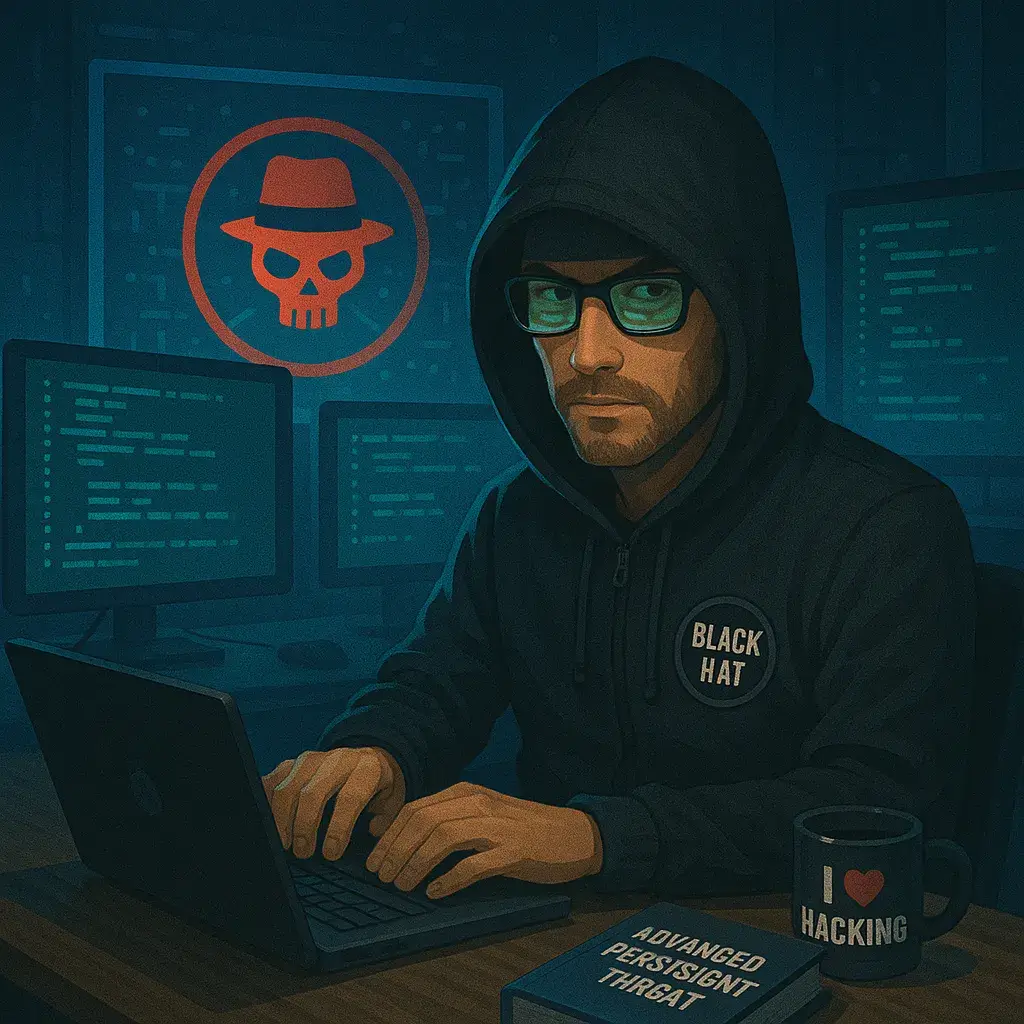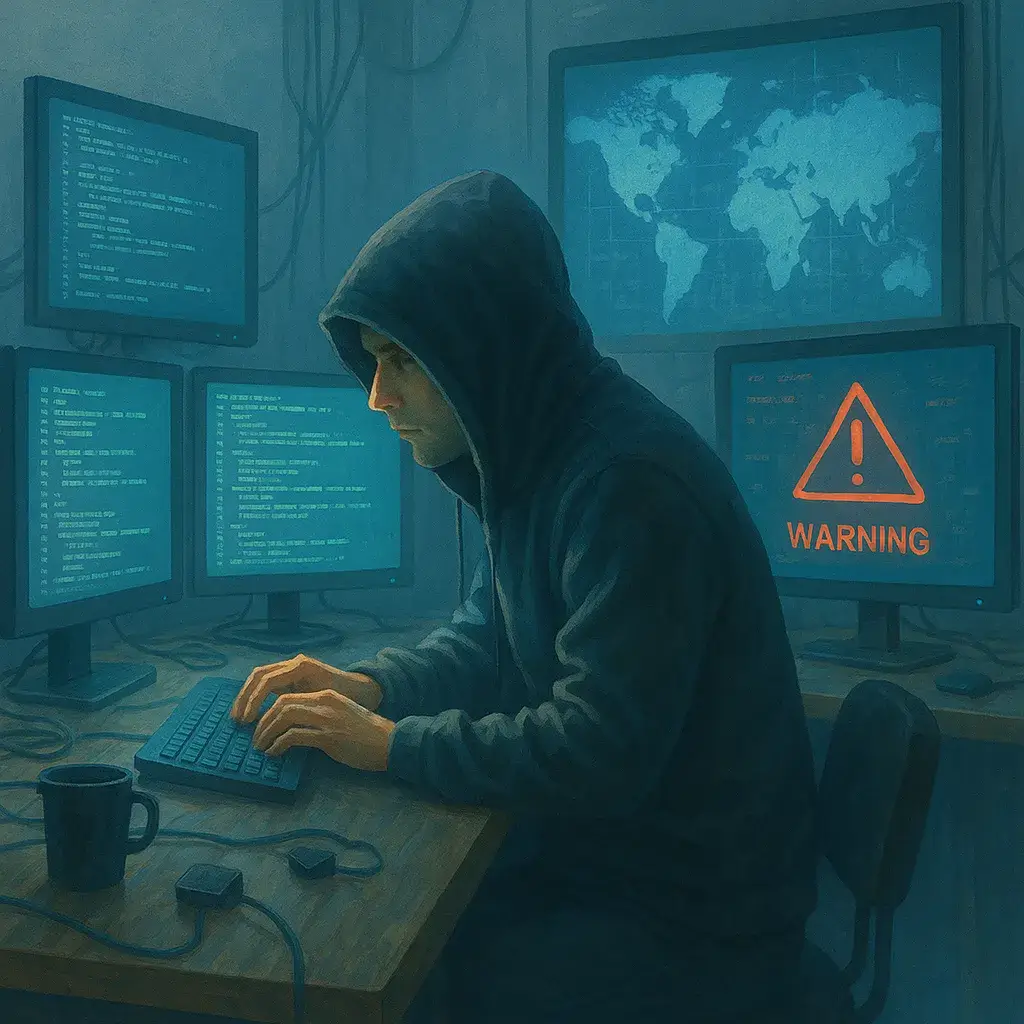The word “hacker” sparks strong emotions: fear, fascination, and sometimes admiration. But most people don’t realize that hacking isn’t inherently criminal — it’s a skillset. The real difference lies in how it’s used. Some hackers fix security problems. Others create them. And a few operate in shadows on behalf of entire governments.
In this article, you’ll discover the four key hacker profiles: white-hat, gray-hat, black-hat, and state-sponsored groups. Each has different motives, techniques, and consequences. The better you understand these roles, the better you can protect yourself — or even build a career in ethical hacking.
🟢 White-Hat Hackers — The Ethical Professionals
White-hat hackers (also called “ethical hackers”) are cybersecurity professionals who use their skills to improve security, not break it. They work with permission, often for companies, governments, or bug bounty platforms.
Their Role
- Perform authorized penetration testing
- Discover and responsibly disclose vulnerabilities
- Help build stronger, safer systems
Real Example
A white-hat hacker participating in a bug bounty program on HackerOne discovered a flaw that allowed bypassing two-factor authentication on a social media platform. Instead of exploiting it, they submitted a detailed report and received a $10,000 reward.
Common Roles
- Penetration testers
- SOC (Security Operations Center) analysts
- Application security engineers
White-hats are the ethical tightrope walkers of the digital world — skilled, precise, and always walking with permission.

🛠️ Practical Table: How to Become a White-Hat Hacker
| 🎯 Step | What to Do | Trusted Resources |
|---|---|---|
| 🧠 Learn the Basics | Networking, Linux, Python | Cybrary, Codecademy, OverTheWire |
| 🔐 Practice Legally | Simulated pentesting environments | TryHackMe, Hack The Box |
| 🏅 Get Certified | CEH, OSCP, Security+ | EC-Council, Offensive Security |
| 💼 Join Bug Bounties | Earn money for real vulnerabilities | HackerOne, Bugcrowd |
| ⚖️ Stay Legal | Always work with permission | Responsible Disclosure policies |
🧪 Face-Off: HackerOne vs. Dark Web Hackers
| Metric | 🟢 White-Hats (HackerOne) | ⚫ Black-Hats (Dark Web) |
|---|---|---|
| Legality | ✅ 100% Legal | ❌ Illegal Everywhere |
| Motivation | Security, Recognition, Bounties | Money, Espionage, Sabotage |
| Tools Used | Nmap, Burp Suite, Metasploit | Malware kits, exploit marketplaces |
| Community | Ethical, Public, Career-Oriented | Anonymous, Hidden, Criminal |
| Outcome | Improved security, trust | Data theft, ransomware, chaos |
⚫ Black-Hat Hackers — The Criminal Actors
Black-hat hackers are the reason cybersecurity exists. These are the malicious actors who break into systems illegally for personal gain, financial reward, espionage, or sabotage. They operate outside the law and ethical boundaries.

Common Tactics
- Deploy malware to steal data or extort victims
- Use phishing attacks to hijack accounts
- Execute ransomware attacks to demand payment in cryptocurrency
- Sell stolen data on dark web marketplaces
Notorious Example
The 2017 WannaCry ransomware attack infected over 200,000 computers across 150 countries. It exploited a vulnerability (EternalBlue) leaked from the NSA (National Security Agency of the United States) and caused billions in damage. Hospitals, governments, and businesses were paralyzed — all within 48 hours.
Black-hat hackers thrive on chaos and financial disruption. They often use anonymization tools and botnets to cover their tracks. Their actions are criminal under nearly every international law, including the Computer Fraud and Abuse Act (CFAA) in the United States.
⚪ Gray-Hat Hackers — The Ethical Wild Cards
Gray-hats fall somewhere in between — a legally and morally ambiguous group. They might find and exploit vulnerabilities without permission, but rather than stealing data, they report the issue after the fact.
Typical Behavior
- Scan public websites or apps for flaws
- Access systems without authorization
- Disclose findings publicly or privately
- Sometimes ask for recognition or payment afterward
Example
In 2019, a gray-hat hacker accessed the admin panel of a small university website, then emailed the IT department with proof and a “request for appreciation.” The school thanked the individual but also contacted local authorities due to the unauthorized access.
The Dilemma
Gray-hats sometimes act out of good intentions, but still break the law. Unauthorized access remains illegal even when no damage is done. Depending on the jurisdiction, gray-hat hackers can face fines or criminal charges.
Their role is like a locksmith who picks your front door to prove it’s weak — and then rings the bell to warn you. Noble? Maybe. Legal? Not always.
🏛️ State-Sponsored Hackers — The Cyber Armies
The most advanced and secretive hackers often don’t work alone — they work for nations. These are state-sponsored hacking groups, also known as APT (Advanced Persistent Threat) groups. Their goals are rarely financial. Instead, they aim for espionage, disruption, or influence.
Characteristics
- Operate with national funding and protection
- Use advanced techniques and zero-day exploits
- Remain hidden in networks for months or years
- Target governments, infrastructure, defense, and global corporations
Known State-Backed Groups (with public reports)
- APT28 (Fancy Bear) — Linked to Russian military intelligence. Accused of hacking the Democratic National Committee during the 2016 U.S. election. Documented in U.S. DOJ (Department of Justice) indictments.
- Lazarus Group — Attributed to North Korea. Behind the Sony Pictures hack in 2014, the WannaCry attack in 2017, and a series of cryptocurrency thefts. Profiled in reports by Kaspersky and Symantec.
- APT41 — A Chinese-affiliated group known for espionage and cybercrime. Their attacks spanned from telecom providers to the video game industry. Reported by FireEye in multiple security bulletins.

Case Study — SolarWinds Hack (2020)
Suspected to be backed by Russia, attackers inserted malicious code into SolarWinds Orion software, used by over 33,000 organizations globally. This supply-chain attack affected U.S. government agencies, including the Treasury and Homeland Security. Reports from Microsoft and CISA (Cybersecurity and Infrastructure Security Agency) detail how the backdoor allowed undetected access for months.
These operations are not just about hacking — they’re about power, influence, and control on a geopolitical scale. The tools used are often invisible to traditional defenses.
🧩 Evolution of Hacking: From Curiosity to Cyberwarfare
1960s — Curiosity
│
├── MIT "hack culture": playful tech modifications (e.g., phone systems, trains)
│
└── The birth of "phreaking" — early phone network explorers (e.g., John Draper aka "Captain Crunch")
1970s — Exploration
│
├── 1971: Blue Boxes popularized by Steve Jobs and Steve Wozniak
│
└── Hacking seen as intellectual challenge, not crime
1980s — Rise of Digital Intrusion
│
├── 1983: "WarGames" movie ignites public fear of hacking
│
├── 1984: Term “hacker” enters mainstream media
│
└── 1986: US passes Computer Fraud and Abuse Act (CFAA)
1990s — Internet Expansion & Criminalization
│
├── Hacker groups emerge: Cult of the Dead Cow, Legion of Doom, L0pht
│
├── 1999: L0pht testifies before US Congress about critical infrastructure flaws
│
└── Law enforcement begins large-scale crackdowns (e.g., Operation Sundevil)
2000s — Globalization of Hacking
│
├── Emergence of nation-state cyber actors
│
├── Massive data breaches (TJX, Heartland)
│
└── Anonymous and hacktivism movements take shape
2010s — Sophistication & Scale
│
├── 2010: Stuxnet — first known digital weapon (allegedly US/Israel)
│
├── 2013–2017: Yahoo, Equifax, WannaCry — billion-scale attacks
│
└── Rise of ransomware, zero-day markets, and cybercrime-as-a-service
2020s — Cyberwarfare & Ethics
│
├── Surge in state-sponsored APTs (e.g., SolarWinds, Microsoft Exchange)
│
├── Ethical hacking becomes professionalized (CEH, OSCP, HackerOne)
│
└── Gray areas deepen: surveillance capitalism, AI-assisted attacks, and privacy tech boom
→ 2025 and beyond:
Hacking is no longer fringe — it's geopolitical, commercial, and cultural.🧠 Bonus: First Real “Hacker”?
- Kevin Mitnick is often called the world’s first high-profile hacker.
- Arrested in 1995 after a legendary FBI chase.
- Now a symbol of redemption — he became a top cybersecurity consultant and author before passing away in 2023.
📊 Comparison Table — Hacker Types at a Glance
| Hacker Type | Authorization | Motivation | Risk Level | Legal? |
|---|---|---|---|---|
| White-Hat | ✅ Yes | Security improvement | Low | ✅ Yes |
| Gray-Hat | ❌ No | Curiosity / Exposure | Medium | ⚠️ Risky |
| Black-Hat | ❌ No | Profit / Destruction | High | ❌ Illegal |
| State-Sponsored | ❌/✔️ Mixed | Espionage / Influence | Maximum | ❌ Often |
🧠 Why This Classification Matters
Understanding the different hacker types helps:
- Organizations build targeted defenses
- Law enforcement prioritize threats
- Aspiring professionals choose ethical paths
- Citizens interpret news and breaches accurately
💡 The same vulnerability could be:
- Patched by a white-hat
- Publicized by a gray-hat
- Exploited by a black-hat
- Weaponized by an APT group
Intent is everything.
🎯 Takeaways for Beginners
If you’re learning cybersecurity:
- White-hat is your path. Ethical hacking is in demand. Certifications like CEH (Certified Ethical Hacker) and OSCP (Offensive Security Certified Professional) are valued globally.
- Avoid gray-hat temptations. Even if your goal is to “help,” unauthorized access can land you in serious legal trouble.
- Stay aware of APT behavior — even if you never work for a government, understanding state-level threats is essential for defense.
You don’t need to be the world’s best hacker. But if you understand the landscape — ethically, technically, and legally — you’ll be far ahead of most.
📦 Myth vs. Reality: What People Get Wrong About Hackers
| ❌ Myth | ✅ Reality |
|---|---|
| All hackers are criminals | White-hats and even some gray-hats protect systems. |
| Hackers are genius coders | Many learn gradually through courses and labs. |
| Hacking takes seconds | Real-world intrusions take days or weeks of planning. |
| “I’m not a target” | Every user and device is a potential attack vector. |
🎯 Key Tips for Aspiring Cybersecurity Pros
⚖️ Ethics matter. The same exploit can be used to help, harm, or manipulate — your choice defines you.
💡 Stick with white-hat hacking. It’s in demand, respected, and pays well.
❗ Never test systems without permission. Unauthorized access = serious legal trouble.
🧠 Study APT group behavior. Even private-sector defenders need to understand nation-state tactics.
❓ FAQ — Understanding Hacker Types
Q1: Are all hackers criminals?
A: No. White-hat hackers are legal professionals who help protect systems. Gray-hats may mean well but still break the law. Only black-hats and many state-sponsored groups commit crimes.
Q2: Is it legal to scan websites or apps for vulnerabilities on your own?
A: Not without permission. Unauthorized scanning or exploitation can violate laws like the CFAA, even if you don’t steal anything.
Q3: Can gray-hat hackers go to jail?
A: Yes. Even if they don’t cause harm, accessing systems without permission is illegal in most countries. Intent doesn’t erase liability.
Q4: How can I become a white-hat hacker?
A: Start by learning networking, Linux, and scripting (like Python). Use legal platforms like Hack The Box or TryHackMe. Get certifications like CEH or OSCP. Never test real systems without permission.
Q5: What’s the most dangerous type of hacker?
A: State-sponsored hackers. Their operations are long-term, well-funded, and capable of disrupting entire governments or economies. Unlike black-hats, their goal is often not money — but control.
Q6: What’s the difference between an APT group and an ordinary black-hat group?
A: APTs are often funded by governments, use advanced tools like zero-days, and stay hidden in networks for months. Black-hats act for personal gain and are more visible and chaotic.
Q7: Is hacking always about code and technical tricks?
A: Not always. Many hacks succeed through social engineering — tricking people, not machines. That’s why cybersecurity is as much about psychology as it is about technology.
Q8: Are there “legal gray zones” where hacking is allowed?
A: Only within defined legal frameworks like bug bounty programs or authorized pentests. Anything else — even if “for good” — can still be prosecuted.
🧾 Glossary of Key Terms
| Term | Definition |
|---|---|
| White-Hat Hacker | An ethical hacker who tests and strengthens security systems with permission. Often works for companies, bug bounty platforms, or governments. |
| Black-Hat Hacker | A criminal hacker who exploits systems illegally for profit, sabotage, or theft. Operates outside legal and ethical boundaries. |
| Gray-Hat Hacker | A hacker who finds vulnerabilities without permission, then reports them — sometimes ethically, sometimes not. A legal gray area. |
| State-Sponsored Hacker | A government-backed attacker (APT group) targeting infrastructure, corporations, or foreign institutions for political, economic, or military reasons. |
| APT (Advanced Persistent Threat) | A long-term, stealthy cyberattack campaign carried out by skilled actors (often state-backed) to infiltrate and maintain access to systems. |
| Bug Bounty | A financial reward given to ethical hackers who legally discover and report security vulnerabilities to companies or platforms. |
| Penetration Testing | Simulated cyberattacks performed to identify weaknesses in systems before malicious actors exploit them. Also known as “pentesting.” |
| Zero-Day Exploit | A vulnerability that is unknown to the vendor and has no available patch — often used by APTs and black-hats. |
| Responsible Disclosure | A protocol where ethical hackers privately report a flaw to the organization before going public, giving time to fix the issue. |
| CFAA (Computer Fraud and Abuse Act) | A key U.S. federal law that criminalizes unauthorized access to computer systems. Applies to many hacking-related offenses. |
✅ Final Note (without links)
Sources referenced include:
MITRE ATT&CK (Adversarial Tactics, Techniques, and Common Knowledge) framework for classifying adversary behavior
U.S. DOJ (Department of Justice) indictments (APT28, 2018)
FireEye Threat Group Reports (APT41, 2020)
Microsoft and CISA (Cybersecurity and Infrastructure Security Agency) advisory reports (SolarWinds breach, 2020)
Kaspersky and Symantec profiles on Lazarus Group
